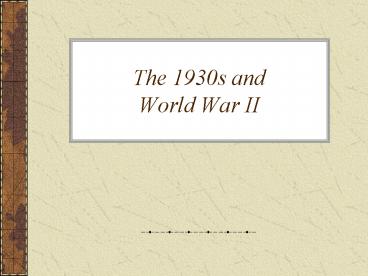The 1930s and World War II - PowerPoint PPT Presentation
1 / 19
Title:
The 1930s and World War II
Description:
System of ideas that aspires both to explain the world and to ... Fascist Ideologies. Opposition to Marxism. Opposition to Democracy. Opposition to Liberalism ... – PowerPoint PPT presentation
Number of Views:38
Avg rating:3.0/5.0
Title: The 1930s and World War II
1
The 1930s and World War II
2
Ideology
- A systematic set of ideas about human life and
culture practical elements as prominent as the
theoretical ones. - System of ideas that aspires both to explain the
world and to change it.
3
(No Transcript)
4
20th Century Ideologies
- Fascism
- Right Wing
- Nationalist
- Race
- Communism
- Left Wing
- Internationalist
- Class
5
Fascism
- A political philosophy or regime that exalts
nation and often race above the individual and
that stands for economic centralized autocratic
government headed by a dictatorial leader, severe
economic and social regimentation, and forcible
suppression of opposition.
6
Common Characteristics of Fascist Ideologies
- Opposition to Marxism
- Opposition to Democracy
- Opposition to Liberalism
- Totalitarian ambitions
- Imperialist
- Violence
- Extreme Nationalism
- Scapegoating
7
Totalitarianism
- Political system where all aspects of human
society are controlled by the state - Hannah Arendt and Friedrich Hayek
- Both fascism and communism reflect totalitarian
forms of government and differences are more
superficial than actual
8
Fascism vs. Communism
- Nationalist
- Totalitarian
- Antidemocratic
- One Party Rule
- Ethnic Pogroms
- Brutal, oppressive, murderous
- State control of economy
- International in theory nationalist in practice
- Totalitarian
- Antidemocratic
- One Party Rule
- Class and ethnic
- Brutal, oppressive, and murderous
- Socialist
9
Manchurian Incident
- Japanese Fascism
- Military leadership dissatisfied with government
policies - Patriotic groups and Kokutai
- Increasing independence of Military
- Assassination of Zhang Zuolin (1928)
- Mukden Incident (1931)
- Creation of puppet state Manchukuo
- Puyi Installed as Emperor
- League of Nations condemns Japan Japanese
delegation walks out
10
Road to War
- Truce with China leaves Japanese Troops in
control of area North of Great Wall - Marco Polo Bridge Incident (July 1937)
- Escalates into full scale War
- Origins of WWII in East Asia
- Japanese confidence
- Attack in Pincer movement from North and landing
at Shanghai - Chinese mount heavy defense
11
Rape of Nanjing Japanese Atrocities
- Rampage 7 weeks of terror, murder, rape
- Estimates
- 200,000 300,000 murder in brutal manner
- 20,000 80,000 women raped
- Institution of Comfort Women System
- Occupation of Philipines
12
Expansion of the War
- Military confrontation with USSR
- Tripartite Pact (September 1940)
- Greater East Asian co-Prosperity Sphere
- Japanese expansion provokes economic sanctions
from United States
13
General Tojo Hideki (1884-1948)
- Prime Minister (Dictator) from October 1941 to
July 1944 - Ordered surprise attack on Pearl Harbor December
7, 1941 - US declares war on Japan Hitler declares war on
US
14
The Course of the War
- By 1942, Japan controlled the Philippines,
Malaya, Burma, and the East Indies - First major defeat by US at battle of Midway
- Island hopping strategy
15
China at War
- Japan cuts off land route to China supplies
flown in over the Hump - General Joseph Stilwell commander of American
forces in China-Burma-India - Misery and corruption in Nationalist China
- Japans seizure of Chinas eastern seaboard
- Chiang conserves strength to fight CCP
16
Accomplishments of CCP
- Headquartered in Yanan after long march
- Party members expands widespread peasant support
- Without sparking class warfare, peasants were
mobilized - Japanese kill all, burn all, destroy all policy
hurts and helps CCP - Power grows out of the barrel of a gun the part
must control the gun
17
Japan at War (Japanese Fascism)
- Dictatorial Leader
- National General Mobilization Law strengthens
Prime Minister at expense of Diet - Economic and Social Regimentation
- Rationing, economic controls, resource allocation
- Purge of western influences
- Heterodox religious sects suppressed all
religions subordinated to imperial cult - Mobilization of public down to ward level
- Suppression of Opposition
- All political parties merged into Imperial Rule
Assistance Association - All labor unions merged into single patriotic
organization - Pressure exerted on education and communications
- Racism Imperialism
- Japanese uniqueness and exceptionalism (Kokutai)
- Asia for Asians
18
Colonial East Asia during War
- Asia for Asians
- Covered up harsh imperial system exploitation of
resources and attempted elimination of indigenous
cultures - Ho Chi Minh returns to Vietnam to lead resistance
against Japanese and French
19
End of War
- Bombardment of Japanese home islands
- 100,000s die in conventional bombs
- Allies seek Unconditional surrender
- Japanese refuse to surrender estimates of
million deaths in case of invasion of home
islands - Kamikaze pilots
- Atomic Bombs dropped USSR declares war on Japan


























